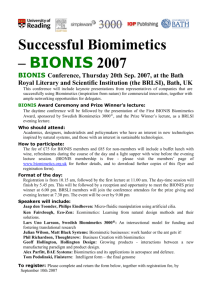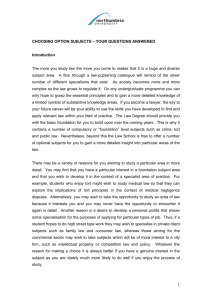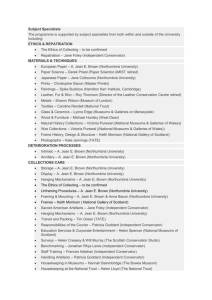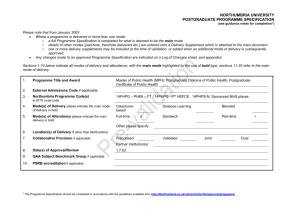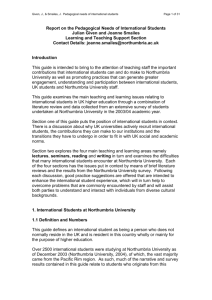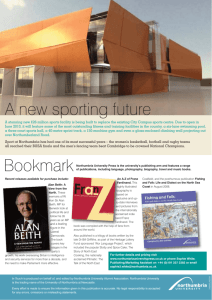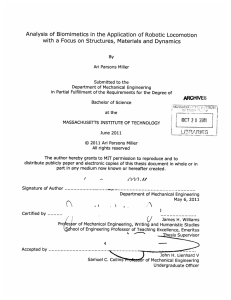- Northumbria Research Link
advertisement
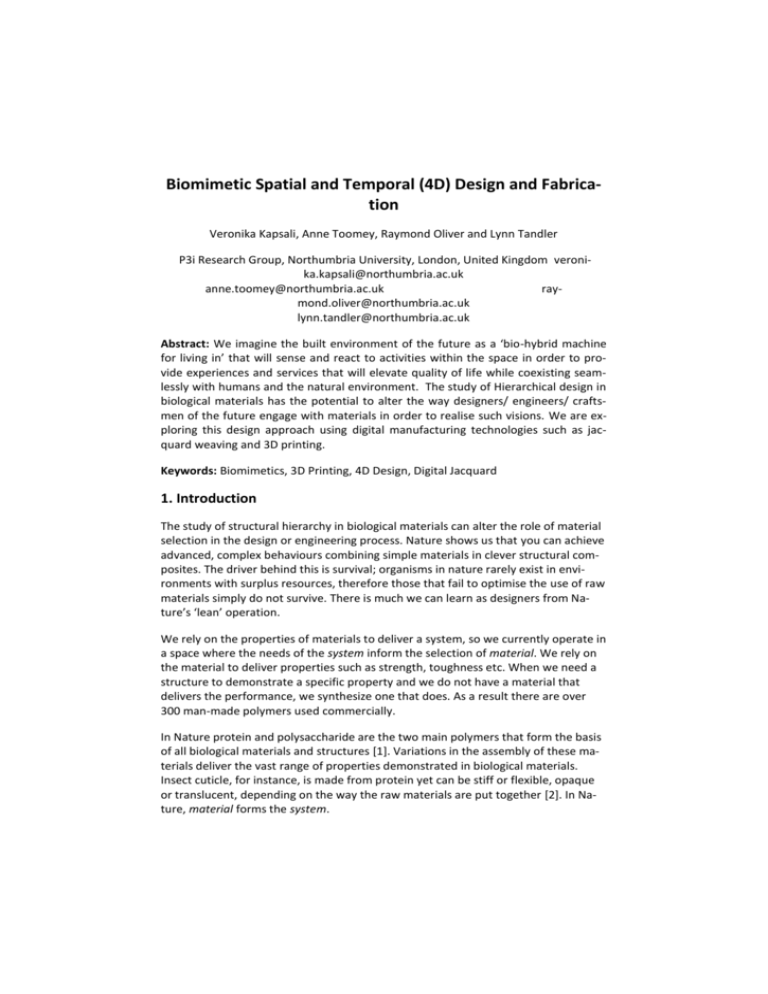
Biomimetic Spatial and Temporal (4D) Design and Fabrication Veronika Kapsali, Anne Toomey, Raymond Oliver and Lynn Tandler P3i Research Group, Northumbria University, London, United Kingdom veronika.kapsali@northumbria.ac.uk anne.toomey@northumbria.ac.uk raymond.oliver@northumbria.ac.uk lynn.tandler@northumbria.ac.uk Abstract: We imagine the built environment of the future as a ‘bio-hybrid machine for living in’ that will sense and react to activities within the space in order to provide experiences and services that will elevate quality of life while coexisting seamlessly with humans and the natural environment. The study of Hierarchical design in biological materials has the potential to alter the way designers/ engineers/ craftsmen of the future engage with materials in order to realise such visions. We are exploring this design approach using digital manufacturing technologies such as jacquard weaving and 3D printing. Keywords: Biomimetics, 3D Printing, 4D Design, Digital Jacquard 1. Introduction The study of structural hierarchy in biological materials can alter the role of material selection in the design or engineering process. Nature shows us that you can achieve advanced, complex behaviours combining simple materials in clever structural composites. The driver behind this is survival; organisms in nature rarely exist in environments with surplus resources, therefore those that fail to optimise the use of raw materials simply do not survive. There is much we can learn as designers from Nature’s ‘lean’ operation. We rely on the properties of materials to deliver a system, so we currently operate in a space where the needs of the system inform the selection of material. We rely on the material to deliver properties such as strength, toughness etc. When we need a structure to demonstrate a specific property and we do not have a material that delivers the performance, we synthesize one that does. As a result there are over 300 man-made polymers used commercially. In Nature protein and polysaccharide are the two main polymers that form the basis of all biological materials and structures [1]. Variations in the assembly of these materials deliver the vast range of properties demonstrated in biological materials. Insect cuticle, for instance, is made from protein yet can be stiff or flexible, opaque or translucent, depending on the way the raw materials are put together [2]. In Nature, material forms the system. Organisms have multiple levels of hierarchy. The organisation of raw materials within and across each level is what enables the rich diversity in properties demonstrated by biological structures [3]. We tend to use less complex non-hierarchical design processes, generally because it is more cost effective to invest in material than skilled labour/ craftsmanship necessary to achieve more complex structures. In this hierarchical classification, the Eiffel tower is a third order design while metal frameworks forming the skeleton of conventional skyscraper buildings are classified as first order structures. The structure of the Eiffel tower is an iron lattice work made from relatively short bars of metal bolted into a shape (1st order), these configurations are assembled into greater structures (2nd order) these in turn are joined to compose the tower (3rd order). The metal framework of conventional buildings is composed of long lengths of structural steel that are bolted together (usually at right angles) to form a 1st order structure. Iron is a relatively weak material especially when compared to the qualities of structural steel used in construction today. Many believed, at the time of its erection, that the Eifel tower would collapse because the quality of the material used to make it was not strong enough to support the weight of the structure. In fact Lakes (1993) estimated that the relative density ρ/ρο (density ρ as mass per unit volume of structure divided by density ρο of material of which it is made) of the Eifel tower is 1.2X103 times that of iron, while the metal skeleton of a skyscraper has relative density 5.7x 10-3 of structural steel [4]. Designing with hierarchy can deliver strong structures from weak materials by managing strength and stiffness of composite systems. If this approach can deliver material systems with counterintuitive properties, can it aid us in the transition from static design to spatial and temporal engineering? 2. Biomimetic Realisation Although Biomimetics has long reaching applications in both the digital and virtual worlds, conventional making processes do not generally lend themselves to mimicking complex architectures. Layered manufacturing methodology is an effective way of exploring artificial muscles and smart soft composite prototypes cheaply and efficiently [5,6] but designs are limited to linear structures. Researchers at Reading University were able to mimic the microfibril orientation of cellulose in wood fibre cell walls, which is responsible for the stiff and ductile properties of wood, into a macro scale prototype. In order to build the prototype, that relied on accurate controlling the orientation of the fibres within a matrix, the team had to design and build a custom machine [7]. ‘Technical plant stem’ is a commercially scalable textile composite that combines high strength and impact resistance with minimal use of material [8]. The design combined knowledge of fibre orientation in wood with the anatomy of the giant reed stem. The prototype was made using advanced braid protrusion machinery at the Institute of Textile Technology and Process Engineering (ITV) Germany. Recent advances in 3D printing technology in terms or resolution (micron versus previous millimetre scale) and range of useable materials have created a new platform for the exploration and experimentation of biologically inspired stimuli responsive 4D systems. This state of the art equipment is currently used in the biomedical sector for the creation of tissue scaffolds, which draw on the fine resolution capacity and the ability to print using high spec biomaterials [9]. We have identified the design principles behind hygroscopic seed dispersal mechanisms primarily in dehiscent legume pods as an ideal paradigm for technology transfer. Study of the hierarchical system reveals that the seedpod valves are simple bilayers systems composed primarily of cellulose. Depending on the degree of difference in orientation of the cellulose microfibrils between these layers, the pods either twist or bend in dry conditions but always revert to their original shape when exposed to moisture. We are exploring shape change for the design of 4D composite systems using the orientation capabilities of advanced 3D Fibre deposition and digital weaving technologies. We wish to present an overview of this work in progress. 3. References 1. Vincent, J.: Structural biomaterials, Princeton University Press. (2012) 2. Vincent, J. F., U. G. Wegst: Design and mechanical properties of insect cuticle. Arthropod Structure & Development 33 vol. 3, 187-199 (2004) 3. Tirrell, J. G., M. J. Fournier: Biomolecular materials. Chemical and Engineering News 72 vol.51, 40-51 (1994) 4. Lakes, R.: Materials with structural hierarchy. Nature 361 vol. 6412, 511-515 (1993) 5. Weiss, L. E., R. Merz: Shape deposition manufacturing of heterogeneous structures. Journal of Manufacturing Systems 16 vol. 4, 239-248 (1997) 6. Ahn, S.-H., K.-T. Lee: Smart soft composite: An integrated 3D soft morphing structure using bend-twist coupling of anisotropic materials. International Journal of Precision Engineering and Manufacturing 13 vol. 4, 631-634 (2012) 7. Jeronimidis, G.: The fracture behaviour of wood and the relations between toughness and morphology. Proceedings of the Royal Society of London. Series B, Biological Sciences: 447-460 (1980) 8. Milwich, M., T. Speck: Biomimetics and technical textiles: solving engineering problems with the help of nature's wisdom. American Journal of Botany 93 vol. 10, 1455-1465 (2006) 9. Moroni, L., J. R. de Wijn: 3D fiber-deposited scaffolds for tissue engineering: Influence of pores geometry and architecture on dynamic mechanical properties. Biomaterials 27 vol. 7, 974-985 (2006)






